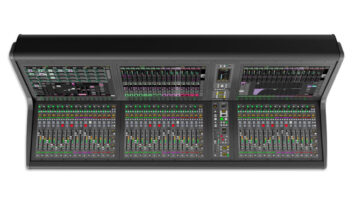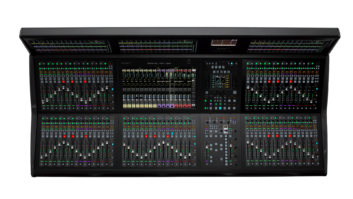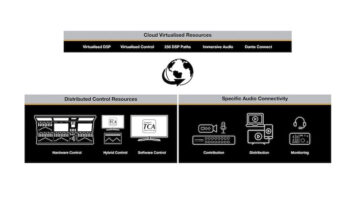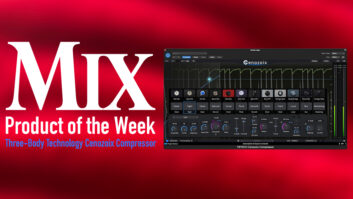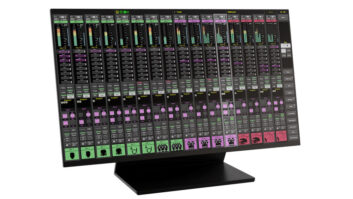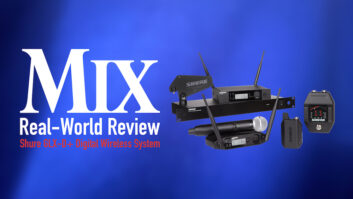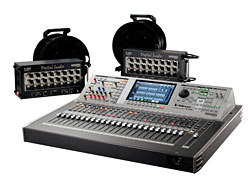

These days in live sound, making the jump to a 48-channel digital mixing system has been well outside the financial reach of many regional sound companies, houses of worship, schools and smaller performing arts centers. Those on a low to midrange budget will definitely be interested in Roland Systems Group’s RSS V-Mixing system, which brings the digital entry point down to the $9k to $13k mark — not just for the console, but for a complete system that includes digital snakes, mic pre’s and split ability for recording, monitor or broadcast positions.
“We are excited to bring a breakthrough, integrated digital solution to the market at an even more affordable price point,” says John Broadbend, director of technology at the Roland Systems Group, the division of Roland that develops products for the commercial and performance A/V industries, including houses of worship, club/casinos, performing arts centers, and rental and staging companies. “The A/V integrator market is where audio and video are starting to come together more and more, and churches are a prime example of that.”
Although the console is targeted mainly toward the church/school market, the system is just as easily at home with regional companies handling corporate gigs and local music events.
THE V-SYSTEM
The RSS V-Mixing System, which debuted last month at the PLASA show in London, incorporates the 48-channel RSS M-400 V-Mixer digital console, a choice of configurable digital snakes with remote-controlled mic pre’s and the ability to conduct multitrack recording via Cakewalk SONAR. The brains of the system is the M-400 V-Mixer, which offers 24 100mm, motorized, touch-sensitive faders; 16 buses, plus main L/R; dedicated knobs for EQ, pan and gain; and an 800 — 480 TFT screen — all within a clean, intuitive layout that was clearly influenced by Roland’s years of effects development. Also onboard are gating, compression and a host of other effects derived from VS technology. System headroom is 18 dB.
Built-in stereo WAV recording and playback are accessible either internally or via USB key. But for those who want to take production to the next level, the system can integrate with Cakewalk’s SONAR REAC, which lets users record 40 tracks of audio using a Windows Gigabit Ethernet port. (Roland’s REAC Ethernet protocol carries 40 channels of 24-bit/96kHz audio, plus MIDI and remote-control data, over Cat-5.) Run Cat-5 cable from the REAC split port directly into your PC and start mixing instantly. As for system redundancy, the S-4000 32-channel snake offers redundant REAC signal via dual Cat-5 cables, a redundant power supply option and a redundant splitter.
With the V-Mixing system, Roland says it is addressing what it calls the “building blocks of any live event” — from inputs onstage to console, to splits to recording, monitoring or broadcast, and back to the stage. “That’s the system approach that we’re taking, thinking about all of those building blocks,” says Tom Stephenson, RSS director of technology. “We’re not selling a mixer, console or desk; we’re providing an integrated system solution.”
THE CAT-5 ADVANTAGE
There are clear sonic advantages to running Cat-5: no high-frequency losses over long cable runs, no induced hums or buzzes, no ground loops. An added bonus for growing churches, schools, etc., is that as their systems expand, they won’t need to tear up concrete to install bulky copper. And there’s the portability factor: You can carry a skinny little 300-foot reel of Cat-5 cable in one hand. Because a split port is already built into the mixer, the system can be split for monitoring, recording or broadcast.
FROM NOVICE TO PRO
The system is designed to function for any level of user. Extensive onboard help starts out simple (i.e., “What is a gate?”) for the beginner and goes deep for the seasoned pro. Custom profiles accessible via user log-in permissions (which can be loaded by a USB key) allow different levels of access to the board. For example, a weekend volunteer running audio for a funeral might only be able to adjust, say, two fader levels; someone mixing front of house for a small church ensemble might also have access to EQ and compression, while the system designer has complete access. In addition, the system allows real-time PC remote control using Remote Desktop, even over the Internet — which might save that designer an unexpected trip back to the venue to troubleshoot. And total system recall means the system can instantly be re-patched and reset back to stored settings.
Beyond these features, the system offers plenty of format flexibility — snake modules can integrate with other analog systems via breakout box, and console I/Os include AES/EBU for a complete digital setup. In addition, the M-400 V-Mixer can be integrated with Edirol video products such as the V-440HD video mixer for live performances where audio-follows-video is needed.
V-Mixing System prices range from $9,295 to $13,795, depending on configuration (from 16 to 48 inputs onstage). For more information, visit www.rolandsystemsgroup.net.
Sarah Jones is the editor of Mix.


